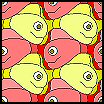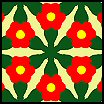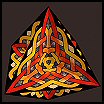Little Adventures
*
The Programs

Symmetoy - In early 1993, I started getting ready to modify my PartyCAD program to run on Windows 3.1. As part of my preparations, I began writing little ‘test case’ programs to become familiar with the new technologies involved. The language I was using was VB6. My son Pete drew a large background, and a picture of an invented hero named Electro Boy. My ELECTROBOY program did little more than move the hero around on the background. Next I experimented with mathematical curves. HYPO was the first, and it drew trochoid curves… the same kind of curves produced by the popular children's toy made by Kenner called a Spirograph. Next came SPIRO, which made star-like spirolaterals, and, finally, I wrote TESS, which drew mathematical tiling patterns. With all this practice, I gradually became comfortable working in the Windows environment, and one night I decided that it was time to try something more ambitious… it was finally time to write my long dreamed of symmetric art program. I ended up calling it SymmeToy, and it quickly became popular with people who wanted to create needlework patterns.
 Symmetoy 2 - By 2007, Symmetoy was looking pretty old to me. The underlying mathematics
of the thing still appealed to me, but the program’s user interface seemed bizarre.
Sure it worked, but it was complicated and confusing to use. I had learned a thing
or two over the years, and so when I set out to learn C# and .NET programming, I
decided I’d take another shot at writing a symmetric art program. I called this one
Symmetoy 2 and it really was better, but in the end, I discovered that I was really
was more interested in writing graphics programs rather than using them, so I never
did much with Symmetoy 2 once it was written.
Symmetoy 2 - By 2007, Symmetoy was looking pretty old to me. The underlying mathematics
of the thing still appealed to me, but the program’s user interface seemed bizarre.
Sure it worked, but it was complicated and confusing to use. I had learned a thing
or two over the years, and so when I set out to learn C# and .NET programming, I
decided I’d take another shot at writing a symmetric art program. I called this one
Symmetoy 2 and it really was better, but in the end, I discovered that I was really
was more interested in writing graphics programs rather than using them, so I never
did much with Symmetoy 2 once it was written.
 Ornamania - In 2012, Pam and I became interested for a while in unit origami. In
this art form, you assemble models using multiple pieces of origami paper. This was
fun for a few weeks, but our interest had begun to fade when Pam discovered a very
simple model called a skeletal octahedron. I liked it. It took only 6 pieces of paper
and 10 minutes to make, and I saw the possibility of creating symmetrically decorated
paper with my computer to allow for the production of an infinite variety of models.
It took some months to do, but I eventually came up with Ornamania, a program that
makes it a joy to create these little models. Of all the symmetry programs I have
ever written, this is the only one that I continue to use on a weekly basis, just
for the fun of seeing what sorts of little creations I can come up with.
Ornamania - In 2012, Pam and I became interested for a while in unit origami. In
this art form, you assemble models using multiple pieces of origami paper. This was
fun for a few weeks, but our interest had begun to fade when Pam discovered a very
simple model called a skeletal octahedron. I liked it. It took only 6 pieces of paper
and 10 minutes to make, and I saw the possibility of creating symmetrically decorated
paper with my computer to allow for the production of an infinite variety of models.
It took some months to do, but I eventually came up with Ornamania, a program that
makes it a joy to create these little models. Of all the symmetry programs I have
ever written, this is the only one that I continue to use on a weekly basis, just
for the fun of seeing what sorts of little creations I can come up with.
* * * * *
PartyCAD is without doubt my best work. I have been developing this program for nearly 30 years now, and it’s a great satisfaction to me that it helps event designers around the world get the job done. But, when it comes time to learn a new language or platform, when it’s time to write a little program to test out a new technology, I always turn to my old-time adventures in symmetry for inspiration.